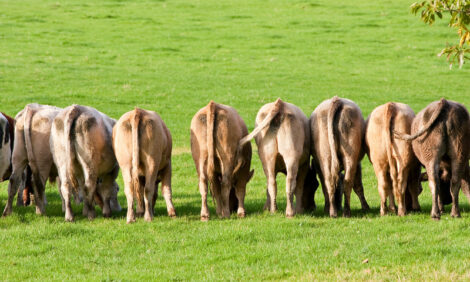



Start Planning For Winter Feeding
US - Looking for a more cost-effective way to feed your cattle this winter? As the demand for hay continues to increase and prices continue to rise, many Midwest cattle producers are searching for cheaper alternatives to winter feeding.
"With more acres going toward corn and soybean production, acres in hay production are lower than normal," said Dan Shike, University of Illinois beef cattle nutritionist and professor in the Department of Animal Sciences.
"The wet spring followed by an extremely hot and dry summer reduced hay production even further. Not only will hay be in high demand in the Midwest and Illinois, but extreme drought in the Southwest will also increase the national demand for hay."
U of I animal scientists have conducted many research studies on alternatives to feeding hay. Shike said one of the best alternatives available to Illinois cattle producers is the use of cornstalks and co-products such as distillers grains, corn gluten feed and soyhulls.
"Grazing cornstalks and supplementing co-products is likely the most economical option in Illinois," he said. "But there are several things to consider when contemplating this decision."
Grazing cornstalks
First, you need to identify a water source. Portable water tanks will work, but if you plan to graze into the winter, then you will want to consider a heating source for the water. In addition, producers must consider fencing options. Mr Shike said temporary electric fence is relatively inexpensive and takes minimal time and labour to put up.
Two options exist for grazing cornstalks — continuous grazing or strip-grazing. Continuous grazing allows cows access to the entire corn field. Strip grazing divides the field up into strips and allows the cows access to a new strip every two weeks.
"Cows will select the residue in the order of corn grain, husks, leaves, and finally, stalks," Mr Shike said. "If you allow the cows access to the entire field, they will eat all of the grain first. There are two potential problems with this scenario. First, the cows can actually eat too much grain. Second, in the process of searching out all of the grain, they can trample in the husks and leaves, which is more of a problem in wet years."
To determine stocking rates, Mr Shike recommends factoring in stage of production and cow size to determine the cows' requirements.
"Corn yield will determine how much residue is available," he said. "When corn yield is high, the amount of residue available is high. If it is dry while you are grazing, the cows' harvesting efficiency is higher than during wet years when more residue will be trampled into the ground."
With so many factors, stocking rates can vary greatly. The final consideration is the length of grazing time. With poorer projected corn yields this year, there will likely not be fewer grazing days available. However, Mr Shike said it is still likely that with one cow per acre, a field could be grazed for 45 to 60 days.
If it's not possible to access cornstalks to graze, producers can also utilised baled cornstalks. Providing ad libitum access to cornstalk bales and offering a co-product supplement is also a good option. Of course, it's cheaper to let the cows harvest the cornstalks, Shike said. But that isn't always an option.
Supplementing with co-products
Again, the amount and type of supplement depends on stage of production and cow size. Spring-calving cows have the lowest nutritional needs in the fall and early winter, Shike said. Full-feeding hay often exceeds their nutritional requirements.
"Unfortunately, cows aren't very good at eating only what they need," he said. "If you offer a high-quality hay, they will actually eat more than if they are fed a lower-quality hay or a crop residue such as cornstalks, soybean stubble or wheat straw."
When it comes to supplementing cornstalks, it's important to consider protein and phosphorous levels. Distillers grains and corn gluten feed are both high in protein and phosphorous. Soyhulls are a good energy source, but they are not as high in protein or phosphorous. As the cows advance in gestation, their requirements go up.
Cornstalk residue and co-products can also meet the needs of lactating cows, Mr Shike said.
"Much of the work we have done at Illinois has focused on lactating cows in late winter and early spring before we can go to grass," he said. "Obviously, the energy and protein requirements are much higher for lactating cows, but this can still be met by co-products."
The requirements of gestating cows can often be met by five to eight pounds of distillers grains or corn gluten feed in addition to ad libitum access to cornstalk bales. However, lactating cows may need as much as 12 to 15 pounds of co-product. The exact amount depends on cow size, milk production levels and the analysis of the cornstalks (or soybean stubble, wheat straw, poor quality hay).
"With hay in short supply and feed costs at record highs, producers need to have a plan in place," he said. "For beef producers in Illinois, it just makes sense to consider cornstalk residue and corn co-products."
TheCattleSite News Desk



